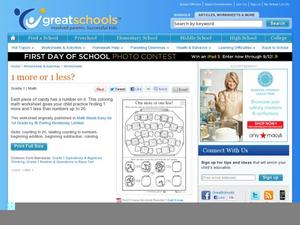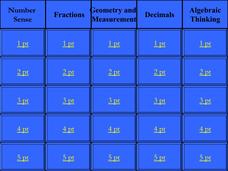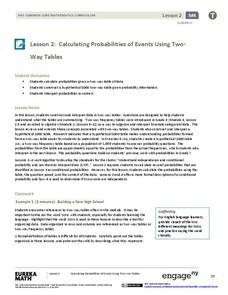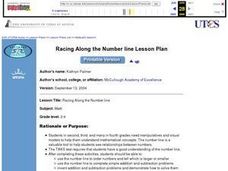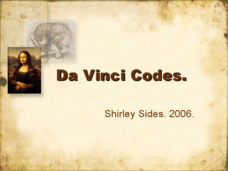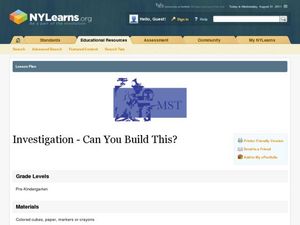Curated OER
Number Patterns
Spot the pattern! Pupils examine nine patterns using numbers 0-13. There are two blanks for learners to complete the pattern. None of these involve difficult math or complex concepts- this is for young pattern-finders. A...
Super Teacher Worksheets
Number Line
It's a printable number line to 100! Cut it out and use the easy tabs to glue into one long number line.
West Contra Costa Unified School District
Interest and the Number e
Mary, Mary, quite continuously, how does your money grow? Uses examples to examine the difference between simple interest and compound interest, and to take a look at different rates of compounding. Learners explore what would...
Buffalo State
A Five Day Approach to Using Technology and Manipulatives to Explore Area and Perimeter
Young mathematicians build an understanding of area and perimeter with their own two hands in a series of interactive geometry lessons. Through the use of different math manipulatives, children investigate the properties of...
Curated OER
Number Pairs
This engaging coordinate pairs activity will have scholars intrigued; they mark 13 points on a grid and then connect them to create a capital block letter. Which one will it be? The grid has whole numbers 0-10 along both axes, so...
Curated OER
One More or One Less?
Hook new mathematicians with a candy-themed approach to addition and subtraction. They examine 10 numbers (not exceeding 19) printed on candy wrappers. For each, learners calculate and record numbers with values one more and one...
Curated OER
Pregnancy, day 1
A health lesson presents all aspects of conception and pregnancy. Fourth through sixth-graders define terms associated with pregnancy, label a chart of a woman, and discuss how pregnancy occurs. Some excellent activities and a wonderful...
Curated OER
General Math Jeopardy
Here's an interactive way to review some basic concepts. Math Jeopardy!! Five categories, five questions each on number sense, fractions, geometry and measurement, decimals, and algebraic thinking. Have fun!!
Curated OER
Natural Disasters and the Five Themes of Geography
Have your class do research on natural disasters and create a presentation using this resource. In completing this activity, learners apply the five geography themes to their research. They write a paper describing their results. It's a...
Curated OER
The Five Senses
Study various objects and help kindergarteners use their five senses to classify the objects. They are presented with various objects and then use their five senses to sort and classify the objects. Then they use a Visual Ranking Tool to...
Curated OER
Building Sets of 13 and 14
Compose and decompose sets of 13 and 14 and compare sets of each with your little learners. They use objects to construct sets of 13 and 14, record their answers, and compare sets in several different ways.
Curated OER
Two-Step Problems and Money Concepts
Elementary schoolers solve two-step equations and practice money concepts. They solve multi-step addition and subtraction contextual problems and apply money concepts to real life situations. Pupils use pictures and counters to help them...
Curated OER
Boat Safety and Water Sports - Lesson 13 - Two Foot Deep Water Start
Lesson 13 is part of a twenty-two lesson plan unit on boat safety and water sports. The focus in this lesson plan is water skiing and using a two-foot start to be able to get up and out of the water. Click on the resource link at...
Curated OER
Large Number Concept
Eighth graders compare objects to large numbers. In this algebra instructional activity, 8th graders compare large numbers to daily objects. Relate large numbers to the real world by discussing the Holocaust and the number of people who...
Curated OER
And 5 More Makes...
By drawing five more objects to existing sets, scholars begin to understand the concept of addition. They count pails and draw five more, totaling them and recording the sums. There are three of these followed by four more similar...
EngageNY
Calculating Probabilities of Events Using Two-Way Tables
Tables are useful for more than just eating. Learners use tables to organize data and calculate probabilities and conditional probabilities.
Curated OER
Find the Rhyme
Which of these objects rhymes? There are four starter pictures here, each heading rows of three objects. Learners determine and circle the row object that rhymes with the first one. Then, they connect two of the CVC words with printing...
Curated OER
Racing Along the Number Line
Manipulatives and visual models really help youngsters understand mathematical concepts. One activity provided here gives every learner their own white board and accompanying number. Then learners have to put themselves in order, holding...
Curated OER
The Da Vinci Code: Math Fun
A wonderful way to introduce or practice simple algebraic equations, where a variable is used in place of a number. Learners will work to crack the Da Vinci Code (as it is called) and replace letter variables with the "code" numbers to...
Curated OER
What's Next?
Teach the class how to continue a given number pattern, and have them state a rule to explain their answer. Arithmetic sequences and related worksheets are used to reinforce the concept of numerical patterns using the nthterm.
Curated OER
Comparing and Ordering Fractions, Mixed Numbers, and Decimals
Create your own fraction kits by folding and labeling paper using fraction vocabulary. Learners then work in groups to use these in comparing and sequencing both whole numbers and fractions. They also create unit cubes and develop an...
Curated OER
Graphing Systems of Inequalities
Solve equations and graph systems of inequalities. Designed as a lesson to reinforce these concepts, learners revisit shading and boundaries along with solving linear inequalities.
Curated OER
Math Review Questions
In this problem solving worksheet, students calculate and solve 52 questions or equations having to do with a variety of math concepts and strategies.
Curated OER
Investigation--Can You Build This?
Early learners explore shapes using colored blocks. They first get some hands-on time with the blocks and then look at beginning math concepts regarding spatial relationships. They work with a partner to build a 6-8 block tower...





